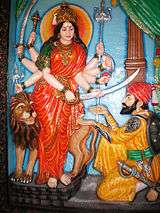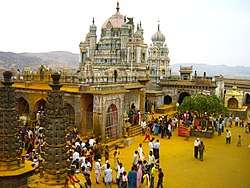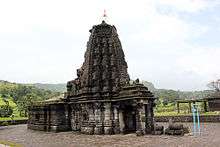Bhavani
| Bhavani | |
|---|---|
| Goddess of Power, Goddess of justice | |
|
A shrine to Bhavani | |
| Affiliation | Shakti, Parvati, Devi |
| Abode | Mount Kailash, Himalayas |
| Weapon | Bow and arrow, sword |
| Mount | Tiger, Lion |
| Consort | Shiva |
Bhavani (also known as Tulaja, Turaja, Tvarita, Ambā and Jagadambā) is an avatar of the Hindu Goddess Parvati. She is a form of Durga who is worshiped in Maharashtra, and also by Gurjars of North Gujarat, Western Rajasthan and Punjab.[1] Bhavani translates to "giver of life", meaning the power of nature or the source of creative energy. She is considered to be a mother who provides to her devotees and also plays the role of dispensing justice by killing demon Asuras.
Bhavani was the protective patron deity of the Maratha King Shivaji, in whose veneration he dedicated his sword, Bhavani Talwar. Many Marathi folk stories celebrate her. Shivaji's mother was said to be a great devotee of Bhavani. The town of Tuljapur in Maharashtra is the location of the annual Tulja Bhavani fair during Navaratri (September to October), and home to the Tulja Bhavani Temple which dates to the 12th century. The temple contains a granite icon of the goddess, one metre (approximately 3 feet) in height, with eight arms holding weapons and the head of the slain demon Mahishasura.
Temples of Bhavani
The Tulja Bhavani temple in Tuljapur in the Osmanabad District of Maharashtra is considered one of the 51 Shakti Pithas (pilgrimage sites). This temple was built close to the 12th century CE. Another Tulja Bhavani temple was constructed between 1537 and 1540 CE in Chittorgarh,[2] located at coordinates 18°00′41″N 76°07′32″E / 18.011386°N 76.125641°E.
History
Worship of the primeval energy, Shakti, in the form of the mother Goddess is seen in the four Shakti Peethas of Maharashtra: Bhavani, with her seat at Tuljapur; Mahalakshmi at Kolhapur; Mahamaya Renuka at Mahur; and Jagadamba at Saptashrungi. Sri Bhavani Amman is also worshipped in the state of Tamil Nadu (Periyapalayam). Other Shakti temples in the Maharashtra state are those at Ambejogai and Aundh.

The goddess Bhavani is held in great reverence throughout Maharashtra. She is considered to be an embodiment of ugra' or ferocity, as well as a Karunaswaroopini, an embodiment of mercy. A number of castes, sub-castes, and families from Maharashtra consider her their family deity or Kuladevata. The Bhavani temple in Tuljapur is located on a hill known as Yamunachala, on the slopes of the Sahayadri range in Maharashtra near Solapur. The temple entrance is elevated and visitors ascend a flight of steps to reach the shrine. Historic records speak of the existence of this temple from as early as the 12th century CE. Bhavani is worshipped in the form of a granite image, 3 feet (0.91 m) tall, with eight arms that hold weapons and bear the head of the slain demon, Mahishasura. Legend says that a demon by the name of Matanga wreaked havoc upon the devas and humans, who approached Brahma for help. Upon his advice, they turned to the Mother Goddess Shakti. She took the form of the destroyer and, empowered by the other Saptamaataas (Varaahi, Bhrahmi, Vaishnavi, Kaumaari, Indraani, and Saambhavi), vanquished the demon and allowed the restoration of peace. Legend also describes how Bhavani vanquished another demon who had taken the form of a wild buffalo, Mahishasura (hence her name Mahishasura Mardhini or "the slayer of Mahisha the demon"). Later, she is said to have taken abode on the Yamunachala hill, which is now home to the temple. Bhavani is said to have come here to save Anubhuti from the demon known as Kukur. In a battle with the goddess, Kukur took the form of a buffalo; Bhavani cut his head, then he started coming in his original form. At that time, she penetrated her trident in his chest. Hence, she is in form of Mahishasura Mardhini Durga. Four worship services are offered at the temple each day. The festivals of special significance are Gudi Padwa in the month of Chaitra, Shriral Sashti, Lalita Panchami, Makara Sankranti, and Rathasaptami. The statue of the deity is taken out in procession on Tuesdays. Navaratri is also celebrated with great fanfare, and it culminates in Vijaya Dasami. Sri Bhavani Devi is said to be Adhi Parashakti herself and the name Bhavani has several meanings. According to Lalitha Sahasranamam, Bhavani means the deity who always helps devotees gain mukti. Adi Shankara said, "A Person who recites the name Bhavani with true devotion thrice every day will not acquire sorrow, sin, illness and unexpected death." People occasionally confuse Bhavani devi with Renuka devi; however, their stories are different. The Devi Bhaghavatam Puran says Bhavani Devi is the original form of Aadhi Parashakti and sister of Shri Krishna. Maha Vishnu is said to have undergone penance to get Devi's help for his Krishna Avatar as a result of which Devi is born to Yashoda as Maha Maaya devi. This is why Bhavani holds a conch and chakra in her hands, thus resembling Vishnu.
Image of Tulja Bhavani
The image (murti ) of Tulja Bhavani is made of black stone, about 3 feet (0.91 m) in height and 2 feet (0.61 m) in width. The face of the goddess is described as beautiful and smiling. The goddess is asta-bhuja (with 8 hands) Mahishasura Mardini Durga. As she is Parvati,[3] she has a swayambhu (self-manifested) Shiva lingam in her crown. Her long hair is coming out of the crown. She has an arrow holder on her back. The sun and the moon are present as witnesses of her victory over Mahishasura. Her lion stands near her. The image is self-manifested and movable. It is moved three times a year from its place to the bedroom of Maa Bhavani. Below the lion, sage Markandeya is chanting the Durga-saptashati shlokas. The lady sage Anubhuti is on the left side of the goddess; she is in a hanging position and is meditating on the goddess. It is chala murti, moved thrice a year during the long sleeping periods of maa Bhavani. The face of Sati had fallen in Tuljapur, and due to this the face is decorated with sarees and ornaments.
See also
Notes
- ↑ Indian studies: past & present, Volume 11. Today & Tomorrow's Printers & Publishers. 1970. p. 385.
The Gujars of Punjab, North Gujarat and Western Rajasthan worship Sitala and Bhavani
- ↑ Mewar encyclopedia Archived June 14, 2007, at the Wayback Machine.
- ↑ Gopal, Madan (1990). K.S. Gautam, ed. India through the ages. Publication Division, Ministry of Information and Broadcasting, Government of India. p. 77.
Further reading
- Hindu Goddesses: Vision of the Divine Feminine in the Hindu Religious Traditions ( ISBN 81-208-0379-5) by David Kinsley


